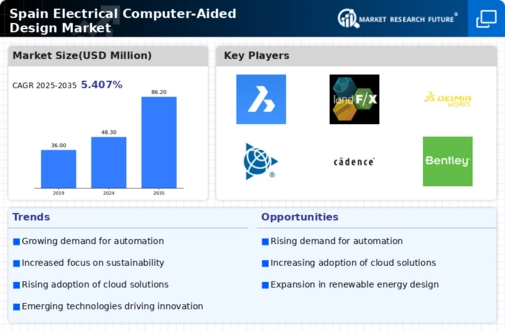Regulatory Compliance and Standards
The electrical computer-aided-design market is significantly influenced by the need for regulatory compliance and adherence to industry standards in Spain. As environmental regulations become more stringent, companies are compelled to adopt CAD tools that facilitate compliance with these requirements. The Spanish government has introduced various regulations aimed at promoting energy efficiency and reducing carbon footprints, which necessitate the use of advanced design software. This regulatory landscape is likely to drive demand for electrical computer-aided-design solutions that can ensure compliance while optimizing design processes. Furthermore, adherence to international standards is becoming increasingly important for companies looking to compete in the global market. As a result, the electrical computer-aided-design market is expected to grow as businesses seek to align their design practices with regulatory expectations.
Rising Demand for Smart Infrastructure
The increasing focus on smart infrastructure development in Spain is significantly impacting the electrical computer-aided-design market. As urbanization accelerates, there is a growing need for intelligent systems that enhance energy efficiency and sustainability. The Spanish government has allocated approximately €10 billion for smart city initiatives, which include the integration of advanced electrical systems. This investment is likely to drive demand for sophisticated CAD tools that can accommodate the complexities of smart infrastructure projects. Consequently, the electrical computer-aided-design market is expected to expand as companies seek to leverage these tools for designing innovative solutions that meet regulatory standards and consumer expectations. The emphasis on smart infrastructure not only fosters economic growth but also positions the electrical computer-aided-design market as a critical player in Spain's technological evolution.
Increased Focus on Education and Training
The electrical computer-aided-design market is benefiting from an increased emphasis on education and training programs in Spain. Educational institutions are incorporating CAD training into their curricula, which is essential for preparing the next generation of engineers and designers. This trend is supported by government initiatives aimed at enhancing technical skills among the workforce. As a result, the number of graduates proficient in CAD software is expected to rise, potentially increasing market demand. Furthermore, industry partnerships with educational institutions are fostering innovation and ensuring that the curriculum aligns with current market needs. This focus on education is likely to create a skilled labor pool that can effectively utilize advanced CAD tools, thereby driving growth in the electrical computer-aided-design market.
Technological Advancements in CAD Software
The electrical computer-aided-design market is experiencing a surge in technological advancements, particularly in software capabilities. Enhanced functionalities, such as 3D modeling and simulation tools, are becoming increasingly prevalent. In Spain, the adoption of advanced CAD software is projected to grow by approximately 15% annually, driven by the need for precision and efficiency in design processes. These advancements enable engineers and designers to create more complex and accurate designs, thereby reducing time-to-market for new products. Furthermore, the integration of cloud-based solutions allows for real-time collaboration among teams, which is essential in today's fast-paced environment. As a result, companies are investing heavily in upgrading their CAD systems to remain competitive, indicating a robust growth trajectory for the electrical computer-aided-design market in Spain.
Growing Adoption of IoT in Design Processes
The integration of Internet of Things (IoT) technologies into design processes is emerging as a key driver for the electrical computer-aided-design market. In Spain, industries are increasingly recognizing the potential of IoT to enhance product functionality and user experience. This trend is prompting designers to utilize CAD tools that can seamlessly incorporate IoT features into their designs. The market for IoT-enabled devices is projected to grow by 20% annually, which in turn is likely to boost the demand for advanced CAD solutions that support these technologies. As companies strive to create interconnected products, the electrical computer-aided-design market is positioned to benefit from this shift, as designers require sophisticated tools to visualize and implement IoT functionalities effectively.
























Leave a Comment